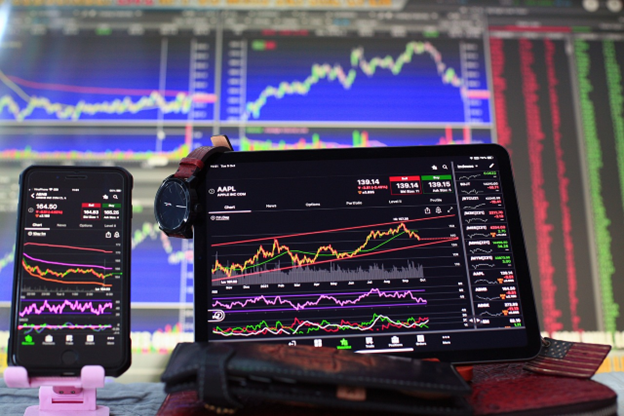High-Frequency Trading: Harnessing Speed For Market Success And Managing Its Risks
November 16, 2023
In the fast-paced world of modern finance, high-frequency trading (HFT) stands out as a pinnacle of technological integration in stock market operations. This trading method, characterized by ultra-high speed and algorithm-driven strategies, has revolutionized how financial markets operate.
HFT leverages powerful computers to transact a large number of orders at lightning speeds. You can find here brokers that allow HFT, but before you start, you should get a thorough understanding of this technology. While it offers significant advantages, it also introduces unique risks that require careful management. This article explores the nuances of HFT, its uses, and the strategies for mitigating associated risks.

Understanding High-Frequency Trading
High-frequency trading relies on algorithms that analyze market conditions and execute orders based on pre-set criteria at speeds often measured in microseconds. These sophisticated algorithms are designed to identify and act on market inefficiencies and arbitrage opportunities before they are recognized by the market at large.
HFT firms usually operate with very thin margins. They make small profits per trade, but the volume of transactions is high enough to generate significant returns. To ensure that such performance is possible, companies have to employ advanced technology, computers, and servers that are able to handle a large number of transactions at incredible speeds. They have to provide high execution speeds and minimal delays or other technical issues.
Uses of High-Frequency Trading
- Liquidity Provision: HFT contributes to market liquidity, making it easier for other participants to trade. High-frequency traders act as market makers, constantly buying and selling securities, thereby reducing bid-ask spreads and aiding in smoother price discovery.
- Arbitrage: HFT algorithms are excellent at identifying price discrepancies across different markets or assets and exploiting them instantaneously, a process known as arbitrage. This helps in maintaining price efficiency across markets.
- Index Fund Rebalancing: HFT strategies are often employed in anticipation of known upcoming market movements, such as index fund rebalancing. These strategies profit from predicting and responding to the market impact of such events.
- Statistical Arbitrage: This involves using statistical models to predict price movements and trade accordingly. HFT algorithms can process vast amounts of market data to identify these trading opportunities.

Managing the Risks of High-Frequency Trading
While high-frequency trading offers numerous benefits, it also comes with its set of challenges and risks. Effective risk management is crucial for the stability and integrity of financial markets.
- Systemic Risk Management: HFT can contribute to systemic risks due to its interconnected nature and reliance on technology. Market regulators and HFT firms must work together to ensure robust risk controls are in place. This includes implementing circuit breakers and kill switches to prevent runaway algorithms.
- Technological Risks: The reliance on advanced technology in HFT implies that technical glitches can have far-reaching consequences. Continuous investment in technology infrastructure and rigorous testing of algorithms are essential to mitigate these risks.
- Market Impact and Volatility: HFT can exacerbate market volatility, especially during turbulent times. Firms should employ strategies that are mindful of the potential market impact, avoiding aggressive trading tactics that could disrupt market stability.
- Regulatory Compliance: HFT firms must navigate a complex web of financial regulations that vary by jurisdiction. Compliance with these regulations is crucial to ensure fair and transparent market operations.
- Latency Risks: In HFT, even a few microseconds of delay can be detrimental. Continuous optimization of infrastructure to minimize latency is vital, along with strategies to mitigate the impact of latency issues.
- Counterparty Risks: The fast pace of HFT means firms often trade with multiple counterparties in a short period. Effective management of counterparty risk is critical to prevent potential financial losses.
The Future of High-Frequency Trading
The future of HFT is inextricably linked to technological advancements and regulatory landscapes. As machine learning and artificial intelligence become more sophisticated, we can expect HFT strategies to become even more advanced and efficient. However, this also means that regulators will need to stay ahead of the curve to manage the risks associated with these advancements.
Furthermore, the global nature of financial markets means that coordination among international regulatory bodies is essential to manage the systemic risks posed by HFT. This includes harmonizing regulations to prevent regulatory arbitrage and ensuring a level playing field for all market participants.
In conclusion, high-frequency trading represents a significant evolution in financial market operations, driven by technological advancements. While it offers considerable benefits such as improved liquidity and efficient pricing, it also introduces new risks that require careful management. The ongoing challenge is to harness the advantages of HFT while effectively mitigating its risks, ensuring the continued stability and integrity of global financial markets.
 His Last Day As A Teacher After 36 Years. They Turned It Into A Memory For Life
His Last Day As A Teacher After 36 Years. They Turned It Into A Memory For Life
 Meet Despereaux, The Adorable Dumbo Mouse You’ll Want To See
Meet Despereaux, The Adorable Dumbo Mouse You’ll Want To See
 Kids Are Loving The Tiny Duck Libraries Popping Up Around New York City
Kids Are Loving The Tiny Duck Libraries Popping Up Around New York City
 'I Laughed And Cried': Vet’s Hilarious Condolence Card Brings Laughter To Grieving Cat Owner
'I Laughed And Cried': Vet’s Hilarious Condolence Card Brings Laughter To Grieving Cat Owner
 A Man Ruined A Beautiful Snowman Display — What Happened Next Was Perfect
A Man Ruined A Beautiful Snowman Display — What Happened Next Was Perfect
 Pet Owners Share Hilarious Stories Of Paying The Vet… Just To Find Out Their Pets Are Weird
Pet Owners Share Hilarious Stories Of Paying The Vet… Just To Find Out Their Pets Are Weird
 Donkey Gets Tricked Into Taking His Medicine — And It’s Adorable
Donkey Gets Tricked Into Taking His Medicine — And It’s Adorable
 Kissing Rescue Dogs And Filming Their Reactions
Kissing Rescue Dogs And Filming Their Reactions
 I Picked Up My Sister From Work At A Doggy Daycare — Then This Happened
I Picked Up My Sister From Work At A Doggy Daycare — Then This Happened
 Pig’s Friends Couldn’t Handle Seeing Him So Scared
Pig’s Friends Couldn’t Handle Seeing Him So Scared
 Watch A Forensic Scent Dog Track Down A Hidden Pen
Watch A Forensic Scent Dog Track Down A Hidden Pen
